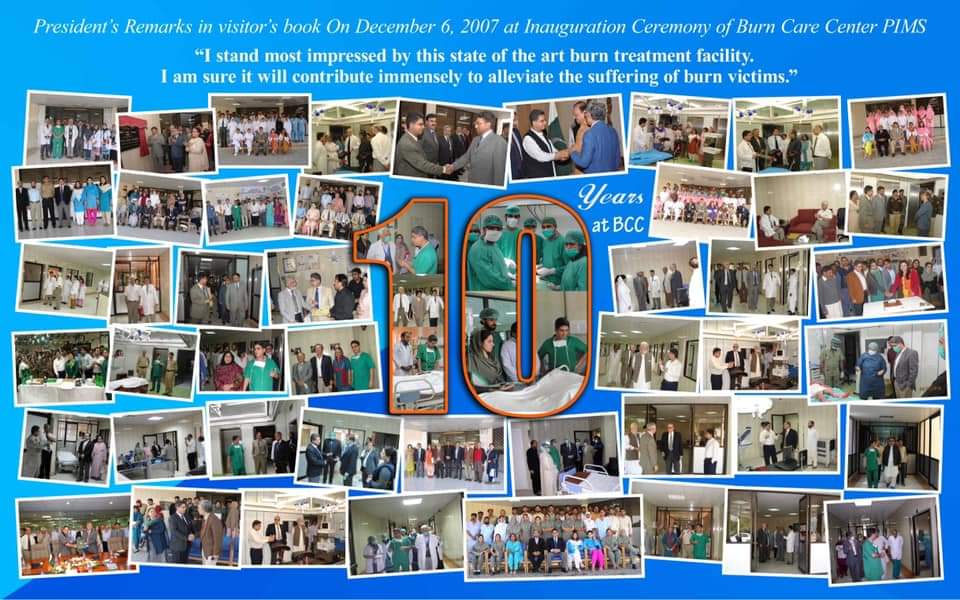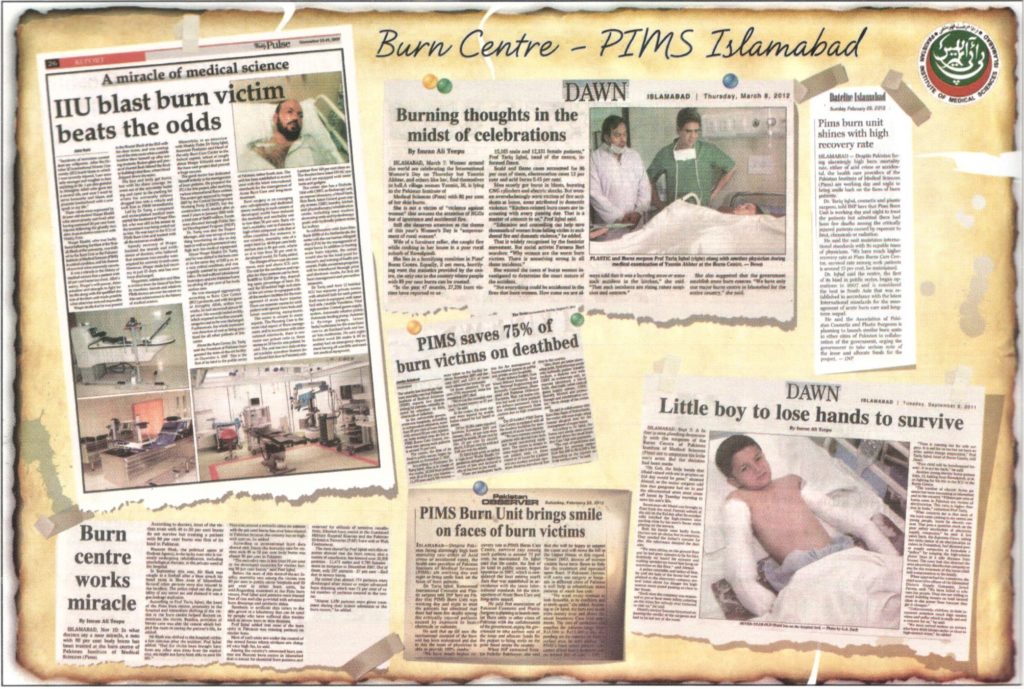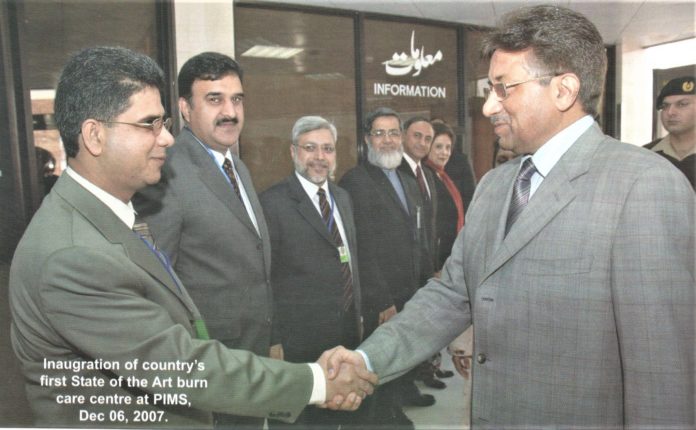Remarkable advances in burn care have been made internationally over recent decades and it is recognized that the organized efforts of burn teams are required to continue enhancing survival rates and quality of life for patients. Patients with major burns are unique, representing one of the most severe models of trauma and therefore necessitate treatment in the best specialized facilities available for that endeavor. Burn centers have been developed to meet these intricate needs but can only function most productively and efficiently through well-organized, multifaceted, patient-centered teams in the areas of both clinical care and research.
During the past 10 years significant advances have been made in the treatment of burns. Modern concepts of therapy are based on a more thorough understanding of the physiological derangements that occur after burning.
In Pakistan the mortality rate for burn victims Pakistan is beyond proportion when compared with other countries. For instance, in our country the mortality rate of a major burn i.e., 40-50% body surface area is 86%, whereas it is less than 20% in the developed world.
In Pakistan the overall data of Burn patients is not available but the Burn Care Center PIMS Islamabad has managed more than 77,000 acute burns during the last 10 years with overall mortality rate of 25%. In the United States nearly 2 million people are burned every year; about 100,000 burns are moderate to severe and require hospitalization and about 5,000 deaths occur because of burns. The overall improvement in mortality and outcome of patients with severe burn trauma over the last decades can be attributed to the following: (1) emergency medical treatment with aggressive early resuscitation, (2) respiratory care and treatment of inhalation injury, (3) control of infection, (4) early burn wound excision and grafting, and (5) modulation of the hypermetabolic response to trauma. There are major developments and changes in burn care regimens concerning emergency medical treatment, application of advance burn dressings for pain and damage control, focusing on the requirement of early fluid resuscitation, criteria for hospital admission, and referral to burn centers. There are changes in respiratory management of burn patients and therapy of inhalation injury, infection control measurements, early burn wound excision and wound coverage, and the nutritional and pharmacological modulation of the hypermetabolic response to trauma. All these burn therapy regimens need to be continuously reassessed in clinical use further improved to achieve still better outcome and quality of life for burn victims.
The magnitude of injury is based upon two principal factors, extent of injury and depth of burn. The extent of burn is usually expressed as the percentage of the total body surface area. For many years Berkow’s table was used as a guide for estimating the percentage of body surface burned. A modification of this table by Tennison and Pulaski into the “rule of nines” has been employed recently. For children, the extent of burn should be increased for the head and trunk and decreased for the extremities. Burns are usually divided into three categories based on depth: first degree, second degree, and third degree.
The delivery of any acute care service, such as burn care, must not only consider the staffing and structure of the team, but also the way in which the team is to be delivered to the patient. It is well recognized that a superior level of care can be provided at a Centre specializing in the treatment of burns. Burn centers are capable of providing a concentrated collection of skilled staff-members with access to intensive care and surgical facilities specifically designated for burn patients. Patient access to the entire burn care team in a facility equipped to deal with the acute and long-term implications of the burn has served to improve patient survival and reduce length of hospital stay.
Modern Burn care is advancing with improvements in outcomes related directly to research efforts from investigators in the field. This is a continuous process that is reflected by manuscripts in the published literature from year to year. Many investigators and clinical sites throughout the world are active in investigating the pathophysiology of burns and testing new and old treatments; all of this is done in an effort to improve processes of care and outcomes in burned patients. These are described in the literature which is the principal means of communicating new knowledge in the medical field. Publication of findings in the scientific literature is the normal and optimal vehicle to communicate for two reasons: (1) peer-review of methods, results, and conclusions to confirm study novelty/validity and to filter findings to those that stand scrutiny, and (2) proliferation of findings throughout the scientific community to engender further discussion and investigation, and potentially change practice.
Unlike many other disciplines, burn care arose from, rather than evolved into, a multidisciplinary team. It is well recognized that burn victims are best cared for in specialized burn centers where experienced healthcare professionals are available to care for the patient 24 h a day.
The structure of a burn care team can be considered in two ways. Team members can be characterized by the area of healthcare that they are involved in delivering. Alternatively, the team can be considered as a collection of individuals, each of whom have a role and respond to guidance from a team-leader.
Telemedicine in burn care has been widely studied for its role in the acute management of burn patients and the outpatient management of those not requiring transfer to a burn Centre. A recent systematic review found extensive level IIA/B evidence supporting the conclusion that photographic and video telemedicine was both effective and feasible in providing acute and outpatient burn care. This study did, however, identify that amongst UK studies that had performed an analysis of the cost effectiveness of telemedicine in acute burn care, the financial savings to the burn Centre investing in the technology were minimal. This was felt to reflect the large start-up costs and relatively low costs of patient transfer when compared with other countries, such as Australia and the USA. The published literature does not, however, consider the net societal cost benefit. Although these interactive programs offer the potential to increase the possible applications of telemedicine within burn treatment, the 21st century burn care team must develop the capacity to manage the technology and tolerate the inevitable learning curve.
Burn victims represent an extremely challenging patient group with multiple medical, psychological and social demands that must be met from the first admission through to late reconstructive surgery and social reintegration. There has been great success in improving the survival and long-term outcome amongst patients with both major and minor burns. Much of this is related to the multidisciplinary approach adopted and clinical research undertaken.

Burn Care Precautions
• Never apply butter or ointment on the burns as this will prevent fast healing.
• Never remove cloths from an open blister in severe burn and never apply cold water to severe burns as a person might go in shock.
• Fire may happen when seniors may not have others around to help.
• The kitchen is one of the most active and potentially dangerous rooms in the home.
• The unsafe use of smoking materials is the leading cause of fire deaths among aging adults.
• Extra caution should be used with alternate heaters such as wood stoves or electric space heaters.
• Homes can have serious wiring problems, ranging from old appliances with bad wiring to overloaded sockets.
• Most kitchen fires occur because food is left unattended on the stove or in the oven. If you must leave the kitchen while cooking, take a spoon or potholder with you to remind you to return to the kitchen.
• Never cook with loose, dangling sleeves that can ignite easily.
• Heat cooking oils gradually and use extra caution when deep-frying.
• If a fire breaks out in a pan, put a lid on the pan.
• Never throw water on a grease fire. Never use a range or stove to heat your home.
• Do not use electric space heaters in the bathroom or around other wet areas.
• Do not dry or store objects on top of your heater.
• Keep combustibles away from heat sources.
• Don’t leave smoking materials unattended. Use “safety ashtrays” with wide lips. Empty all ashtrays into the toilet or a metal container every night before going to bed.
• Never smoke in bed. Better yet stop smoking.
• l Check steaming containers carefully, using the cover to protect your face from steam burns.
• Be very careful around hot surfaces and open flames. Grills, ranges, and ovens are all areas where you can easily get burned if you’re not careful.
• When frying in a pan or with a deep fat fryer, place food carefully into the hot oil so that it doesn’t splash and burn you.
• Hot food can burn, too, of course. So, you always want to handle hot food. carefully while it’s cooking and when serving it.
• Take precautions to avoid spilling hot liquids.
• Be careful when stirring or moving pots with hot liquids.
Burn safety at home
Many ordinary things in a home from bath water and hot food to electrical outlets can cause childhood burns. To prevent burns, follow these burn-safety tips:
• Reduce water temperature. Set the thermostat on your hot water heater to below 120 F (48.9 C). Consider installing anti-scald devices on bathtub faucets and shower heads. Always test the water temperature before your child gets in the tub.
• Avoid hot spills. Don’t cook, drink or carry hot beverages or soup while holding a child. Keep hot foods and liquids away from table and counter edges. Don’t use tablecloths or placemats, which young children can pull down. When you’re using the stove, use back burners and turn the handles of your pots and pans inward. Avoid leaving food cooking on the stove unattended.
Scalds, Flames and Hot Objects
• Scalds are burns that are due to hot liquids.
• Set your home water heater to no higher than 120 to 125 degrees Fahrenheit to prevent water from getting excessively hot. “Anti-scald” devices can also be installed for taps and showerheads. Parents holding their children should never drink hot beverages simultaneously to prevent any untoward accidents. Flames and hot objects are other sources of burns. When using a stove, keep pot handles from pointing outward. Never leave the stove unattended. Keep matches and other flammables away from children. A working smoke detector on every floor of a home can save lives.
Chemical and Electrical Burns
• Chemical burns can occur from skin exposure or even from ingestion of corrosive agents.
• Dangerous chemicals should be stored in safe, child-proof containers and kept in a locked cabinet. All chemicals should be stored in properly labeled bottles old food containers should never be used for this purpose.
• Wear gloves when handling toxic chemicals such as ammonia or bleach. To prevent electrical burns, have an electrician check your wiring every decade and use child safety plugs to prevent children from playing with electrical outlets.
• Never use electrical appliances while showering.
Preventing burns due to fire
• Avoid touching electrical switches and appliance with wet hands. This can cause shock circuit and ignite fire.
• Keep electrical appliance away from water. Especially, water geysers and aluminum water heaters in bathrooms, curling irons, hair dryers, etc. cause major problems.
• Make sure that no live wires are hanging in any corner of your house and in the bathrooms. If there are any live hanging wires, call an electrician and get them fixed.
• Keep children away from electrical switches.
• Ask you electrician to keep the switches at a height that is out of your child’s reach.
• Install a stove shield while cooking the food and cook the food on rear burners.
• You need to be very cautious while cooking the food in the kitchen.
• Do not allow your children to come close to the burners in the kitchen.
• Keep the handles of the pans facing the wall so that, you do not thump them while cooking.
• Turn off the main supply to the stove at night before going to bed.
• Tie your hair properly while cooking the food and while handling any fire sources. Hair catches fire more easily than any other body part.
• Do not smoke where there are any inflammable sources; also, do not smoke on the bed.
• If you are going for a long vacation, switch off the main supply of the electricity and check your house properly.
• Keep fire extinguishers in your house. Keep it in a place that is easily accessible.
• If you came in contact with fire and burn yourself, do not put water on the burnt area. It can worsen the condition.

How to improve Burn Care in Pakistan
Despite many medical advances Burns continue to remain a challenging problem especially in developing world due to:
• Lack of infrastructure (Public & Private Hospitals)
• Lack of Trained professionals (Doctors & Paramedical staff)
• Very high cost of treatment
• All these have an impact on the outcome. There is very little information on the pattern of outcomes among burn patients in relation to clinical aspects in Pakistan.
• Establishing Burn Care Center is one part but equally important is the trained dedicated staff and continuous supply of materials like emergency advance dressing kits, synthetic skin, biological dressings, etc. For a 20 bedded Burn Center a staff of 200 trained personals is required that include Burn Surgeons, Intensivists, anesthetists, ICU Nurses, Technicians, Dressers and other paramedics. The Work load of 20 bedded burn center is equal to a 200 bedded surgical ward, this is the reason it is so expensive and requires so much staff.
• In Pakistan Burn Center PIMS is the only institute that is providing specialized training to doctors (Burn Specialists) and Nurses, recognized by PMDC.
Recommendations
• To upgrade the existing infrastructure of burn facilities across the country including the defense facilities a Burn Center Kharian was established in 1986 and at that time was the only state-of-the-art facility in the country but later was not upgraded so it provides limited treatment options (there is plan to upgrade it to the level of PIMS Burn Center).
• To establish Burn Centers in all major cities along with Teaching hospitals and Burn Units of 4-8 beds in all DHQ hospitals with dedicated staff and budget.
• l to start teaching program (Burn Specialists) at all teaching hospitals.
• l Financial and other incentives for the staff working in these centers.
• Along with establishing these facilities equally important is the public awareness from dangerous practices at home and work places and introduction of strict safety protocols for all gas and electric appliances as data shows that 99% of burns are accidental.
• We have the highest incidence of high voltage electric burn injuries in SE Asia just because many high-tension lines are passing over crowded residential areas.
• 70% of the total burns are pediatric burns (majority household scalds & flame) and all can be prevented by education of families and by practicing strict safety protocols.




